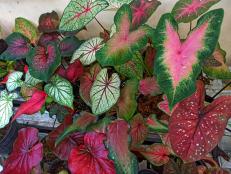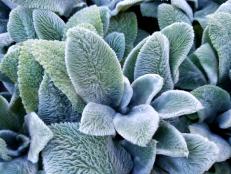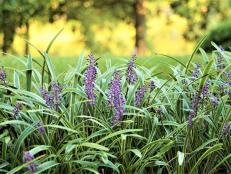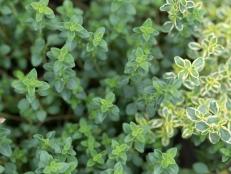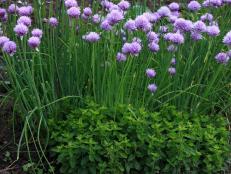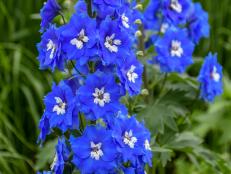How to Grow Lily of the Valley
Dress up your yard’s shady spots with the fragrant blooms of lily of the valley flowers — an old-fashioned favorite.

PerennialResource.com
When buying lily of the valley, look for named varieties to get the best flower and plant forms. 'Bordeaux’ lily of the valley (Convallaria majalis ‘Bordeaux’) opens larger flowers on stems that stand above the leaves, as opposed to stems that are tucked between leaves.
Beautiful and tough-as-nails, lily of the valley graces the garden's shady nooks with perfumed blooms in spring. Lily of the valley flowers usually open in hues of purest white, although there are pink lily of the valley varieties.
Planting lily of the valley is the secret to a low maintenance groundcover that's hardy in Zones 2 to 7. The plant needs cold weather to stage its best show, which is why it's prettiest in regions with colder winters. In these zones, the flower show often starts later and extends into early summer.
Clues that reveal the meaning of lily of the valley are found in the plant's botanical or scientific name, Convallaria majalis. Convallaria comes from the Latin word for valley ("convallis"), while the Latin word "majalis" means "belonging to May," which is when lily of the valley flowers appear.
Botanical name: Convallaria majalis
Common Name: Lily of the Valley
Bloom Time: May (late spring)
Bloom Color: White, some pink available
Special features: Low-maintenance groundcover
Plant Type: Perennial
Size: 6 to 12 inches tall and 12 to 24 inches wide
USDA Hardiness Zones: 2 to 7
This pretty perennial goes by a host of names, including May bells, May flower and May lily, a nod to its three- to four-week flowering window in — you guessed it — May. Despite the name, lily of the valley is unrelated to lilies but is actually in the same plant family as asparagus.
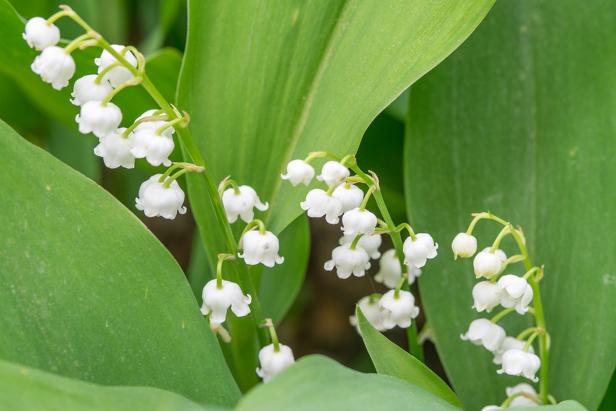
iBulb.org
Lily of the valley thrives in shade, from deep to light. Fragrant flowers appear in late spring to early summer and make a terrific miniature bouquet for bringing the sweet scents of spring indoors.
Plants usually grow 6 to 12 inches tall and, like many groundcovers, have a reputation for wandering. Lily of the valley spreads by stolons (above-ground stems) and rhizomes (underground stems).
Planting Lily of the Valley
Where to Plant Lily of the Valley
Lily of the valley craves shade. In the wild, you'll frequently find it growing in a woodland beneath tall trees that cast dappled shade. Moist, well-drained soil that's rich in organic matter yields best growth, but this groundcover is versatile, adapting to any soil — clay, sand, acidic or dry. The one thing it can't stand is strong, all day sun or hot, dry conditions. Plantings that receive dappled sun often develop brown leaves when summer dog days arrive.
When to Plant Lily of the Valley
The best time to plant lily of the valley varies depending on what form you buy. If you're buying it in pots or square flats with a large section of plants, you can tuck plants into soil in spring when all danger of frost is past.
Look for bareroot plants (called pips) in early spring (or sometimes in fall), often sold in small plastic bags in the same display as bulbs or bareroot fruit plants. Tuck these lily of the valley plants into soil as soon as you buy them. Lily of the valley typically takes two years to flower when planted bareroot.
You can also score big bargains on lily of the valley by purchasing potted plants in summer or early fall, when plants aren't flowering. These out-of-bloom plants often populate discount tables at nurseries or garden centers at these times of year. If you buy a potted lily of the valley in summer, wait to plant until fall. Keep the pot in a shady spot, watering as needed to keep leaves from wilting.
Growing Lily of the Valley
Watering
Lily of the valley growing in a sunnier spot typically slips into dormancy as summer heat arrives. You can coax a longer season of green by providing regular water to plants, enough to keep leaves from wilting. Lily of the valley plants growing in shade don't typically need additional water.
Fertilizing
Lily of the valley doesn't have a big appetite. Top dress plantings with an inch or two of rich compost (composted leaves, manure or bagged compost products) in spring when stems have poked through soil. Compost nourishes plants and helps build nutrient-rich soil.
Dividing
Groundcovers that spread like lily of the valley grow best when you divide them every few years. Overcrowded plantings don't flower as well. A dwindling flower show is a good signal that it's time to divide the plants.
In early spring or late fall, when plants are dormant, dig them up and separate individual growing points or pips. You don't have to be too careful at this point. You can literally dig up chunks of it, remove some and let other chunks remain to spread into empty spaces. Move chunks to other places in your yard or share them with friends. Newly planted pips may not flower for a few years.
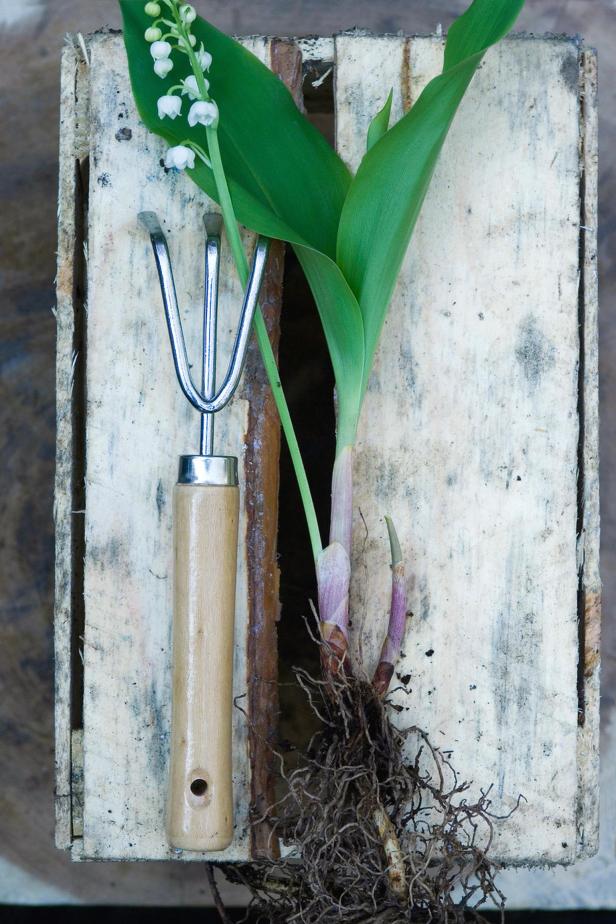
iBulb.org
Lily of the valley is a perennial with a fibrous root system. The best time to dig and divide it is after flowering, either in early summer or fall.
If you have lily of the valley that you're not going to plant or give away, do not put it into the compost until you've let it bake in the sun on a tarp or piece of cardboard for a week or so to kill the plants. Otherwise, you risk filling your compost pile with live roots that will sprout new plants.
Lily of the Valley Varieties
Most lily of the valley varieties offer white blossoms, although a pink lily of the valley is available. Some varieties have larger flowers, while others have a tamer nature and won't run amok in your garden. Here are a few popular varieties:
- 'Rosea' — This is a pink lily of the valley; the color deepens when plants grow in full shade.
- 'Bordeaux' (shown, top of page) — Longer stems make this the type to grow for bouquets.
- 'Flore Pleno' — Double flowers create a stronger show on stems.
- 'Albostriata' — Variegated leaves have creamy yellow stripes to provide color all season. This variety doesn't spread as aggressively.
- 'Fortin's Giant' — Flowers are almost twice normal size, and leaves are fatter and a deeper green. Plants reach 12 to 18 inches tall.
Landscaping with Lily of the Valley
- Tuck lily of the valley near the base of trees or under shrubs like azalea and rhododendron.
- Use it on the north side of buildings or in other shady spots where grass just won't take hold.
- Interplant with periwinkle (Vinca minor) for a springtime show of pale blue and white blossoms.
- In a shade bed, plant lily of the valley with leafy perennials, such as hosta, ferns or variegated Solomon's seal.
- For a pretty spring flower show, choose perennial bloomers like bleeding heart, Siberian bugloss (Brunnera), hellebores or columbine.
Lily of the Valley FAQs
Is lily of the valley poisonous?
Every part of this plant is poisonous — roots, stems, leaves, flowers and berries. The poison is characterized as having low toxicity, meaning you would have to consume large amounts to experience ill effects. Still, it's a good idea to keep pets and children from ingesting any part of it. Because of the toxic compounds lily of the valley contains, deer, rabbits, voles and other critters tend to leave it alone.
What are lily of the valley berries?
Flowers can fade to form red berries, but this only happens if you have plants that haven't all grown from the same root (rhizome) or stem (stolon) structure. In most colonies, the plants are all essentially clones, having grown from the same parent plant. As a rule, lily of the valley flowers are self-sterile, so they need to be cross-pollinated with flowers from a different plant to make fruit.
Is there a blue lily of the valley?
Blue lily of the valley does not currently exist. There are plants being sold online that masquerade as blue lily of the valley. If you look closely at the photos, they're actually grape hyacinth plants (Muscari).
Is lily of the valley invasive?
This groundcover forms colonies over time and can overrun planting beds. Contain it with some type of garden edging or regular dividing, digging out unwanted chunks when the plant is dormant.

.-Battle-on-the-Beach-courtesy-of-HGTV.-.jpg.rend.hgtvcom.196.196.suffix/1714761529029.jpeg)






